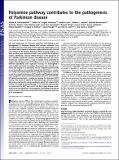Polyamine pathway contributes to the pathogenesis of Parkinson disease
Author(s)
Lewandowski, Nicole M.; Ju, Shulin; Verbitsky, Miguel; Ross, Barbara; Geddie, Melissa L.; Rockenstein, Edward; Adame, Anthony; Muhammad, Alim; Vonsattel, Jean Paul; Ringe, Dagmar; Cote, Lucien; Lindquist, Susan; Masliah, Eliezer; Petsko, Gregory A.; Marder, Karen; Clark, Lorraine N.; Small, Scott A.; ... Show more Show less
DownloadLindquist_Polyamine pathway.pdf (886.6Kb)
PUBLISHER_POLICY
Publisher Policy
Article is made available in accordance with the publisher's policy and may be subject to US copyright law. Please refer to the publisher's site for terms of use.
Terms of use
Metadata
Show full item recordAbstract
The full complement of molecular pathways contributing to the pathogenesis of Parkinson disease (PD) remains unknown. Here we address this issue by taking a broad approach, beginning by using functional MRI to identify brainstem regions differentially affected and resistant to the disease. Relying on these imaging findings, we then profiled gene expression levels from postmortem brainstem regions, identifying a disease-related decrease in the expression of the catabolic polyamine enzyme spermidine/spermine N1-acetyltransferase 1 (SAT1). Next, a range of studies were completed to support the pathogenicity of this finding. First, to test for a causal link between polyamines and α-synuclein toxicity, we investigated a yeast model expressing α-synuclein. Polyamines were found to enhance the toxicity of α-synuclein, and an unbiased genome-wide screen for modifiers of α-synuclein toxicity identified Tpo4, a member of a family of proteins responsible for polyamine transport. Second, to test for a causal link between SAT1 activity and PD histopathology, we investigated a mouse model expressing α-synuclein. DENSPM (N1, N11-diethylnorspermine), a polyamine analog that increases SAT1 activity, was found to reduce PD histopathology, whereas Berenil (diminazene aceturate), a pharmacological agent that reduces SAT1 activity, worsened the histopathology. Third, to test for a genetic link, we sequenced the SAT1 gene and a rare but unique disease-associated variant was identified. Taken together, the findings from human patients, yeast, and a mouse model implicate the polyamine pathway in PD pathogenesis.
Date issued
2010-09Department
Massachusetts Institute of Technology. Department of Biology; Whitehead Institute for Biomedical ResearchJournal
Proceedings of the National Academy of Sciences
Publisher
National Academy of Sciences (U.S.)
Citation
Lewandowski, N. M., S. Ju, M. Verbitsky, B. Ross, M. L. Geddie, E. Rockenstein, A. Adame, et al. “Polyamine pathway contributes to the pathogenesis of Parkinson disease.” Proceedings of the National Academy of Sciences 107, no. 39 (September 28, 2010): 16970-16975.
Version: Final published version
ISSN
0027-8424
1091-6490